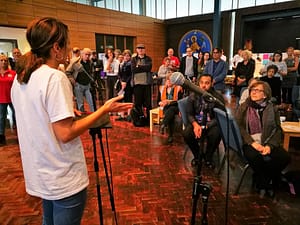The Community Plan for Holloway was initiated by the Centre for Crime and Justice Studies (CCJS) with the aim of ensuring that community voices would be effectively heard. This was so that the Holloway Prison site would be redeveloped to benefit the community, meeting social needs rather than developers’ profits.
In March 2019, the Community Plan became an independent not-for-profit limited company. This achieved two things:
- It handed control to the local partnership group, the Board of Directors, made up of local organisations, who had been involved in the project from the beginning.
- It was a very quick way of setting up a bank account so that the Community Plan could accept money from grant funders.
The Centre for Crime and Justice Studies, based in Lambeth, no longer plays a role.
In August 2019, the Tudor Trust gave the Community Plan a grant of £20,000 for year one and £20,000 for year two of the project to employ a staff member and set up a local office to support the project.
What is the next step in handing control of the Community Plan over to the local community?
While the not for profit limited company was a good way of enabling the Community Plan to set up a bank account, control rests with the company Directors. The next step is to set up an organisation owned and controlled by the community as a whole.
The Board of Directors propose to change the Community Plan for Holloway into a transparent, democratic and accountable body that is owned and controlled by the local community.
There are several ways this can be done. At the Community Plan public meeting on Thursday 7 November we want the community to come together to discuss what type of organisation they want to see set up.
The core aim of the Community Plan for Holloway will remain: to ensure that all parts of the community of Holloway, and of Islington more widely, receive the best possible outcomes from the development of the former Holloway Women Prison site.
Similarly, our strategy to achieve this aim will remain: that the Community Plan for Holloway is the key coordinating hub for the local community during all phases of the Holloway development, ensuring their community’s voices are heard.
What do the Directors of the Community Plan think is the best way forward?
The existing Directors of the Community Plan for Holloway have assessed the various options available and their recommendation is to re-constitute as a charitable incorporated organization (CIO).
This is because a CIO enables the benefits both of wider membership, with a one person one vote system, has a clear set of rules, and will allow easier access for funding for what we want to achieve.
On the next panel you will see a grid outlining the pros and cons of the different types of organisations below:
- A not for profit limited company – the Board of Directors remain in control (stay as we are)
- Unincorporated association – a contractual arrangement between individuals who have agreed to come together to form an organisation for a particular purpose – it does not have charitable status.
- Charitable incorporated organisation (CIO) – a CIO using the ‘association’ model also has a wider voting membership to make key decisions including appointing trustees.
- Community interest company – a special form of non-charitable limited company, which exists primarily to benefit a community or with a view to using its profits and assets for the public good.
- Community benefit society – a society registered with the Financial Conduct Authority, owned by the members and established for the benefit of the community and not of its members.






